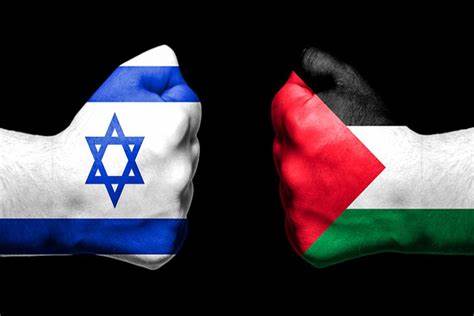The scale and complexity of Saturday’s attacks by Hamas shocked leaders across the world. They came after decades of a relentless and deadly conflict that has killed thousands of people, forced entire generations to grow up under occupation, or created constant anxiety of impending rocket fire or bombings.
Here is a summary of the main events of the conflict, which spans two centuries.
1949: Egypt, Syria, Iraq, Lebanon and Jordan declared war on Israel a day after their independence.
1949: Israel signed a series of truces with Arab countries with Egypt gaining control of the Gaza Strip.
1956: Israel, together with France and Britain, invaded Egypt after they nationalized the Suez Canal, cutting Israel off from shipping.
1957: After pressure from US and Soviet, Israel withdrew from Egypt except from Gaza Strip.
1967: After a six-day war where Israel confronted assaults by Palestinian militants based in Syria, Lebanon and Jordan, Israel regained control of Sinai, the West Bank, Gaza and the Golan Heights.
1973: Egypt and Syria launched a surprise offensive to regain their lost territories but Israel retained control of the Sinai peninsula. Nearly 2,700 Israeli soldiers died in the 19-day war and thousands were injured.
1978: Israel invaded southern Lebanon in March after attacks by the Palestine Liberation Organisation from Lebanon from Jordan. Israel withdrew in a week after forcing the PLO away from the border.
1979: Egypt and Israel signed a peace treaty at the White House which led to Israel’s complete withdrawal from the Sinai Peninsula.
1982: Israel invaded Lebanon again after cross border clashes with the PLO. The invasion led to the siege of Beirut and the exile of the PLO’s leadership to Tunisia.
1987: Palestinians living in the West Bank and Gaza started the First Intifada against Israel. Muslim Brotherhood members founded Hamas, an acronym for “Harakat Al-Muqawama Al-Islamia” – Arabic for Islamic Resistance Movement.
1993: Mr. Arafat signed the Oslo accords with Israel, and committed to negotiating an end to the conflict based on a two-state solution.
1993 Hamas opposed the Oslo Accords, a peace pact between Israel and the Palestine Liberation Organization (PLO) and launched a series of suicide bombings in Israel.
1996: The opening of a new access tunnel near the al-Aqsa Mosque compound, a gesture perceived by the Palestinians as a desecration of this holy site, provoked clashes that left more than 80 people dead in three days.
1996: Israel launched a big offensive against the militant Lebanese Hizbollah group due a sustained guerrilla campaign against Israe. Israel withdrew from Lebanon four years later.
1997: Two suicide bomb attacks killed 27 people, and Israel’s prime minister, Shimon Peres, said he would wage an incessant war against Hamas.
2000: Negotiations between Israel and Palestine failed, a Second Intifada began against Israel. Palestinian youths threw stones at the Israeli police. Support for Hamas continued to grow in Palestine because of its readiness to fight Israel. Palestinian militant groups carried out a sustained campaign of suicide bombings while the Israeli military responded with a crackdown.
2005: Israel withdrew from Gaza in 2005. Hamas subsequently won the elections that sparked a civil war in Gaza between the Islamists and the losing Fatah party that ended in 2007 with Hamas taking over the coastal strip.
2005: Hamas kidnapped an Israeli soldier leading to Israel and Egypt intensifying the imposed border restrictions in response.
2006: Hizbollah militants kidnapped two Israeli soldiers in a cross border raid. Israel launched an offensive against Hizbollah which lasted for 34 days and killed hundreds of Lebanese and dozens of Israelis
2008: In response to hundreds of rocket fire from Gaza, Israel launched an attack on Hamas targets leading to the death of 1,200 Palestinians and 13 Israelis
2009: Israel and Palestinian groups declared unilateral cease-fires, then Israel withdrew from Gaza, and redeployed to the strip’s perimeter.
2012: Israel killed Ahmed al-Jabari, Hamas’s military chief, setting off more than a week of an exchange of fire in which more than 150 Palestinians and at least six Israelis are killed.
2014: Hamas kidnapped and killed three Israeli teenagers, prompting Israeli air and ground offensive against Hamas in Gaza. The war, which lasted a month and a half, killed dozens of Israelis and more than 2,000 Palestinians.
2018: At least 170 Palestinians were killed as Israel responded to protests along the barrier fence that separates Gaza and Israel.
2021: the Israeli police raided Al Aqsa Mosque in Jerusalem, the third-holiest site in Islam, which set off an 11-day war between Israel and Hamas.
2021: Hamas fired more than 3,700 rockets into Israel following weeks of tension in and around Jerusalem. Israel responded by pounding Gaza with air strikes and artillery. This exchanged killed more than 200 Palestinians and more than 10 Israelis.
2022: After a spate of terrorist attacks in Israeli cities, Israeli forces killed at least 166 Palestinians in the Israeli-occupied West Bank.
2023: On several occasions this year, hundreds of Israeli forces carried out military raids in the Palestinian city of Jenin. In January, a Palestinian man killed seven people outside a synagogue in East Jerusalem.
2023: Around 6:30 a.m. on Saturday, Militants from Gaza then entered Israel by land, sea and air and Hamas claim to have fired 5,000 rockets at Israel. Israel puts the figure at 2,200 rockets. 350 people were killed in Israel and the names of 44 Israeli soldiers killed in the attack has been published.
2023: In response to the attack, Israel launched “Operation Swords of Iron, striking 426 targets in Gaza, including 10 towers it said were used by Hamas. By nightfall, Israeli airstrikes on the territory had killed at least 313 people with another 1,990 were injured.
